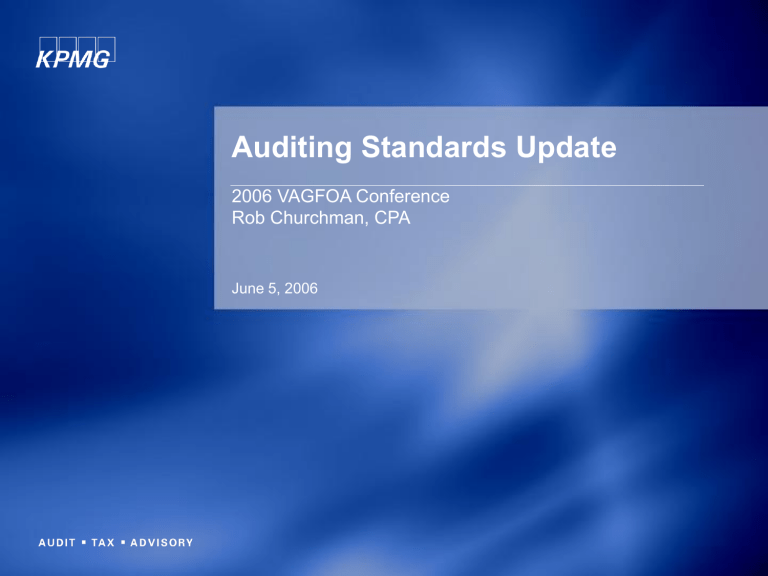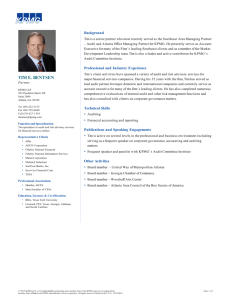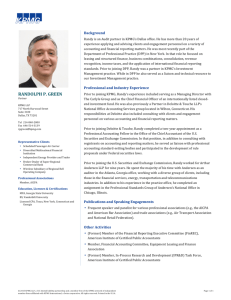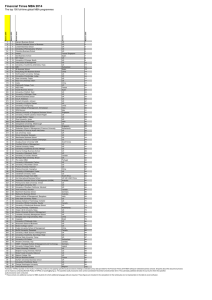KPMG Talkbook Full-page

Auditing Standards Update
2006 VAGFOA Conference
Rob Churchman, CPA
June 5, 2006
What Will Be Covered
•
AICPA Auditing Standards Board (ASB) and other Standard-Setters
•
The Latest on AICPA Auditing Standards
© 2006 KPMG LLP, the U.S. member firm of KPMG International, a Swiss cooperative. All rights reserved. Printed in U.S.A.
11297ric
1
Auditing Standards Setters
•
U.S. Government Accountability Office (GAO)
– Yellow Book
•
Government financial audits, attestation engagements, and performance audits
•
American Institute of Certified Public Accountants (AICPA)
•
U.S. financial audit and attestation standards for entities other than publicly traded companies
•
Public Company Accounting Oversight Board (PCAOB)
•
Financial auditing standards for public companies traded on the U.S. exchanges
•
International Auditing and Assurance Standards Board (IAASB)
•
Financial audit and attestation standards used throughout the world
© 2006 KPMG LLP, the U.S. member firm of KPMG International, a Swiss cooperative. All rights reserved. Printed in U.S.A.
11297ric
2
SAS 102 and SSAE No. 13
•
Issued in December 2005; effective on issuance
•
SAS No. 102 and SSAE 13 define the terminology the ASB will use to describe the degrees of responsibility that the requirements impose on the auditor/practitioner
•
Will result in clarification of standards
•
Terms are substantially similar to those defined by the PCAOB in its Rule 3101
•
Unconditional requirements
•
The auditor is required to comply in all cases
• Indicated by the words “must” or “is required to”
•
Presumptively mandatory requirements
•
The auditor is required to comply
•
In rare circumstances the auditor/practitioner may depart from the requirement provided he/she documents the justification and how alternative procedures performed were sufficient to achieve the objectives of the requirement
• Indicated by “should”
© 2006 KPMG LLP, the U.S. member firm of KPMG International, a Swiss cooperative. All rights reserved. Printed in U.S.A.
11297ric
3
SAS 103 Audit Documentation
•
Effective for periods ending on or after December 15, 2006; supersedes SAS No. 96
•
The ASB considered:
•
The documentation requirements of PCAOB Auditing Standard No. 3
•
The documentation requirements of IAASB ISA 230
•
Government Auditing Standards
•
Suggestions received from NASBA
•
Prepare audit documentation in sufficient detail to provide an experienced auditor with no previous connection to the audit a clear understanding of the work performed, the evidence obtained and its source, and the conclusions reached
•
Enhanced guidance on matters that should be documented
•
Guidance on documentation that should be retained
•
Oral explanations on their own do not represent sufficient support for work the auditor performed or conclusions reached
•
May be used to clarify or explain audit documentation
•
Document audit evidence that is contradictory or inconsistent with final conclusions and how the auditor addressed the contradiction or inconsistency
© 2006 KPMG LLP, the U.S. member firm of KPMG International, a Swiss cooperative. All rights reserved. Printed in U.S.A.
11297ric
4
SAS 103 Audit Documentation (continued)
•
Assemble the final audit engagement file within 60 days following the report release date.
•
After 60 days
– no deletion or discard of existing audit documentation
•
After 60 days
– appropriately document subsequent additions
•
Minimum file retention period of five years from the report release date
• Dating of the auditor’s report:
•
Not earlier than the date on which the auditor has obtained sufficient appropriate evidence to support the opinion
• When do you have “sufficient appropriate evidence”?
•
When you are at a point that you would be comfortable signing the report and releasing to the client
© 2006 KPMG LLP, the U.S. member firm of KPMG International, a Swiss cooperative. All rights reserved. Printed in U.S.A.
11297ric
5
Risk Assessment Standards
•
Recently issued risk assessment standards:
•
SAS No. 104, Amendment to Statement on Auditing Standards No. 1
•
SAS No. 105, Amendment to Statement on Auditing Standards No. 95, Generally
Accepted Auditing Standards
•
SAS No. 106, Audit Evidence
•
SAS No. 107, Audit Risk and Materiality in Conducting an Audit (Audit Risk and
Materiality)
•
SAS, No. 108, Planning and Supervision
•
SAS No. 109, Understanding the Entity and Its Environment and Assessing the
Risks of Material Misstatement (Assessing Risks)
•
SAS No. 110, Performing Audit Procedures in Response to Assessed Risks and
Evaluating the Audit Evidence Obtained (Performing Procedures)
•
SAS No. 111, Amendment to Statement on Auditing Standards No. 39, Audit
Sampling
© 2006 KPMG LLP, the U.S. member firm of KPMG International, a Swiss cooperative. All rights reserved. Printed in U.S.A.
11297ric
6
Risk Assessment Standards (continued)
•
Originated as a joint project between the ASB and IAASB about the time work began on
SAS No. 99
• Enhances the auditor’s application of the audit risk model in practice by requiring:
•
More in-depth understanding of the entity and its environment, including its internal control, to identify the risks of material misstatement in the financial statements and what the entity is doing to mitigate them
•
More rigorous assessment of the risks of material misstatement of the financial statements based on that understanding
•
Improved linkage between the assessed risks and the nature, timing, and extent of audit procedures performed in response to those risks
© 2006 KPMG LLP, the U.S. member firm of KPMG International, a Swiss cooperative. All rights reserved. Printed in U.S.A.
11297ric
7
How the SASs Affect Practice
•
The quality and depth of the required understanding of the entity and its environment, including its internal control, is significantly enhanced
•
Discussion among engagement team
•
Understand the 5 components of internal control (Control environment, Risk assessment, Control activities, Information and communication, and Monitoring)
•
Industry, regulatory, and other external factors
•
Objectives and strategies and related business risks
• Measurement and review of the entity’s financial performance
•
Internal control
•
SAS No. 109, Assessing Risks, paragraphs 21
– 101
© 2006 KPMG LLP, the U.S. member firm of KPMG International, a Swiss cooperative. All rights reserved. Printed in U.S.A.
11297ric
8
How the SASs Affect Practice (continued)
•
The auditor should assess the risks of material misstatement at the financial statement level and at the relevant assertion level on all audits based on the understanding obtained
•
Assertions about classes of transactions
•
Assertions about account balances
•
Assertions about presentations and disclosures
•
Identifying risks through considering:
•
The entity and its environment, including its internal control
•
Classes of transactions, account balances, and disclosures
•
Relating the identified risks to what could go wrong at the relevant assertion level
•
Considering the significance and likelihood of the risks
•
SAS No. 109, Assessing Risks, paragraphs 102-121
•
The auditor should have an appropriate basis for his/her audit approach. Default to maximum for control risk assessment is disallowed.
•
SAS No. 110, Performing Procedures , paragraph 8
•
Testing of controls is encouraged
© 2006 KPMG LLP, the U.S. member firm of KPMG International, a Swiss cooperative. All rights reserved. Printed in U.S.A.
11297ric
9
How the SASs Affect Practice (continued)
•
The requirement to link assessed risks and the audit procedures responsive to those risks is improved
•
Risk assessment is a continuous process, not a series of discrete stages
•
Respond to the risks at the financial statement level and relevant assertion level by:
•
Developing overall responses to the assessed risk at the financial statement level
•
Determining the nature, timing, and extent of further audit procedures at the relevant assertion level
•
Perform further audit procedures that are clearly linked to risks at the relevant assertion level by:
•
Performing tests of the operating effectiveness of controls
•
Performing substantive procedures
•
Evaluating the adequacy of presentation and disclosure
•
Evaluate whether sufficient competent audit evidence has been obtained
•
Greater emphasis is placed on testing of disclosures
•
Guidance on evaluating audit findings is clarified and expanded
•
Documentation requirements are significantly expanded
© 2006 KPMG LLP, the U.S. member firm of KPMG International, a Swiss cooperative. All rights reserved. Printed in U.S.A.
11297ric
10
Iron Curtain/Rollover Issue
•
In evaluation of audit findings, the auditor should consider the effects of misstatements related to prior periods.
•
Guidance in SAS No. 107, Audit Risk and Materiality , paragraphs 52 and 53 is neutral.
© 2006 KPMG LLP, the U.S. member firm of KPMG International, a Swiss cooperative. All rights reserved. Printed in U.S.A.
11297ric
11
Risk Assessment Standards
• SAS No. 104 amends SAS No. 1 to clarify that “reasonable assurance” is a “high level of assurance”
•
All eight standards are effective for all audits beginning after December 15, 2006
•
The ASB plans to have a comprehensive roll out plan to assist auditors which will include:
•
Risk Alert
•
Authoritative Audit Guide geared towards smaller audits
•
CPE Courses
•
Conferences
© 2006 KPMG LLP, the U.S. member firm of KPMG International, a Swiss cooperative. All rights reserved. Printed in U.S.A.
11297ric
12
SAS No. 60 Revisions
•
Recognizes that body to whom communication is made may take different forms:
•
Board of Directors
•
Committee of management
•
Single owner
•
Those charged with governance = the persons with responsibility for overseeing the strategic direction of the entity and the entity’s financial reporting and disclosure process
•
Conforms definitions of control deficiency, significant deficiency, and material weakness to those in PCAOB AS#2 . The term significant deficiency replaces the term reportable condition
•
Requires written communication of significant deficiencies and material weaknesses to management and those charged with governance.
•
Should be communicated even if they were communicated in connection with previous audits
© 2006 KPMG LLP, the U.S. member firm of KPMG International, a Swiss cooperative. All rights reserved. Printed in U.S.A.
11297ric
13
SAS No. 60 Revisions (continued)
• A significant deficiency is a control deficiency, or combination of control deficiencies … such that there is more than a remote likelihood that a misstatement of the entity’s financial statements that is more than inconsequential will not be prevented or detected.
•
Significant deficiencies may involve one or more of the five internal control components
•
A material weakness is a significant deficiency, or combination of significant deficiencies, that results in more than a remote likelihood that a material misstatement of the financial statements will not be prevented or detected.
•
Provides guidance in evaluating:
•
Deviations in the design or operation of controls and whether those deviations constitute control deficiencies
•
The severity of control deficiencies
•
Based on nature, likelihood, and magnitude
• Whether misstatements or potential misstatements are “more than inconsequential”
•
Identifies control deficiencies that ordinarily would be considered at least significant deficiencies
•
Identifies circumstances that should be regarded as at least a significant deficiency and a strong indicator of a material weakness
© 2006 KPMG LLP, the U.S. member firm of KPMG International, a Swiss cooperative. All rights reserved. Printed in U.S.A.
11297ric
14
SAS No. 60 Revisions, continued
•
After concluding on severity of deficiency (control deficiency, significant deficiency, material weakness), to consider whether “prudent individuals” having knowledge of facts and circumstances would come to same conclusion.
•
Written communication required no later than 60 days following issuance of audit report
•
Provides illustrative written communications
•
Includes an appendix containing examples of circumstances that may be control deficiencies, significant deficiencies, or material weaknesses
•
Expected to be voted for issuance by the ASB in April 2006.
•
Proposed effective date = periods ending on or after December 15, 2006
© 2006 KPMG LLP, the U.S. member firm of KPMG International, a Swiss cooperative. All rights reserved. Printed in U.S.A.
11297ric
15
Implications of SAS 60 Revisions
•
Yellow Book will adopt new terminology
•
Currently looking at how internal control reporting may change as a result
•
The big question is what action OMB will take with regard to single audits
•
The other big question is what action the numerous federal agencies with audit guides
(for example, HUD and Education) will take.
© 2006 KPMG LLP, the U.S. member firm of KPMG International, a Swiss cooperative. All rights reserved. Printed in U.S.A.
11297ric
16
Proposed Communications SAS
• The Auditor’s Communication with Those Charged with Governance; would replace
SAS No. 61, Communication with Audit Committees
•
The proposed SAS:
•
Broadens the applicability to audits of all non-issuers
•
Establishes a requirement for the auditor to determine that certain significant matters related to the audit are communicated
•
Proposed effective date = periods beginning on or after December 15, 2006.
•
Comment period ends on May 31, 2006.
• Defines “those charged with governance” and “management”
•
Identifies matters to be communicated (many are carryovers from SAS No. 61).
•
Requires the auditor to determine the appropriate persons with whom to communicate particular matters.
•
Defines what must be communicated and how
© 2006 KPMG LLP, the U.S. member firm of KPMG International, a Swiss cooperative. All rights reserved. Printed in U.S.A.
11297ric
17








